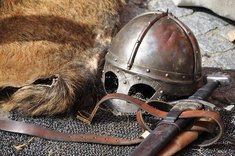Featured Quizzes
User Quizzes
Create Quiz
Data and Charts
Badges and Games
About JetPunk
JetPunk Shop
Dark Mode

Medieval Weapons and Armor
Medieval weapons and armor throughout the early and late medieval times
Rate:
Last updated: August 16, 2019
You have not attempted this quiz yet.
More quiz info >>
| First submitted | August 15, 2019 |
| Times taken | 140 |
| Average score | 35.7% | Report this quiz | Report |
2:15
Enter answer here
0
/ 14 guessed
Time Used
00:00
Best Time
00:00
The quiz is paused. You have remaining.
Scoring
You scored / = %
This beats or equals
% of test takers
also scored 100%
The average score is
Your high score is
Your fastest time is
Keep scrolling down for answers and more stats ...
|
Marvo7
+2
Level 60
Aug 2, 2022
No, disrespect, but there are many inaccuracies here. You allow 'zweihander' from the German, but not Montante, Claymore, Double-hander, and many other names for the large greatsword. You don't allow halberd, glaive, or many other terms for the long poleaxe pike. And what does 'resembles THAT OF a simple walking stick' mean? Bad wording. It resembles the stick. Also, lamellar brigandine type armour should also allow 'squamous' or scale.
bculbertsonTX
+1
Level 35
Apr 18, 2024
what's worse is that the Zweihander was a very very specific two-handed sword that would have a sort of cross guard in close to the actual crossguard so that the Landsknecht using it could go to a knee and plant and get low so as to deal with a horse or a knight on a horse. He/she would have been better served just putting longsword.
WilderA
+1
Level 51
Nov 1, 2023
Great quiz. Nominated!
orangesarenice
+1
Level 57
Jan 25, 2024
As Marvo stated, this quiz has a lot of inaccuracies, and that's why I don't rate it very highly.
New and Popular
Save Your Progress
Copyright H Brothers Inc, 2008–2024
Contact Us | Go To Top | View Mobile Site
